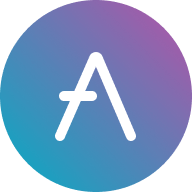AAVE-Preis
in AEDÜber AAVE
Haftungsausschluss
OKX gibt keine Investitions- oder Vermögensempfehlungen. Du solltest sorgfältig prüfen, ob der Handel oder das Halten digitaler Assets angesichts deiner finanziellen Situation für dich geeignet ist. Bei Fragen zu deiner individuellen Situation wende dich bitte an deinen Rechts-/Steuer- oder Anlagenexperten. Weitere Einzelheiten findest du in unseren Nutzungsbedingungen und der Risikowarnung. Durch die Nutzung der Website eines Drittanbieters („TPW“) akzeptierst du, dass jegliche Nutzung der TPW den Bedingungen der TPW unterliegt. Sofern nicht ausdrücklich schriftlich angegeben, steht OKX einschließlich seiner verbundenen Unternehmen („OKX“) in keinerlei Verbindung zum Eigentümer oder Betreiber der TPW. Du stimmst zu, dass OKX nicht für Verluste, Schäden oder sonstige Folgen haftet, die sich aus deiner Nutzung der TPW ergeben. Bitte beachte, dass die Nutzung einer TPW zu einem Verlust oder einer Minderung deiner Assets führen kann. Das Produkt ist möglicherweise nicht in allen Ländern verfügbar.
Preisentwicklung von AAVE
AAVE auf Social Media
Anleitungen

Erstelle ein kostenloses OKX-Konto.
Zahle Gelder auf dein Konto ein.
Wähle deine Krypto aus.
Häufig gestellte Fragen zum AAVE-Preis
AAVE ist eine dezentrale Krypto-Kreditplattform, die das Ausleihen und Verleihen digitaler Vermögenswerte erleichtert. AAVE automatisiert den Kreditvergabeprozess mithilfe intelligenter Verträge und macht ihn so effizient und sicher. Das Protokoll konzentriert sich auf überbesicherte Kredite, bei denen Kreditnehmer mehr Krypto-Assets als Sicherheit hinterlegen müssen, als sie leihen möchten.
AAVE unterscheidet sich in mehrfacher Hinsicht von Compound (COMP). AAVE bietet Schnellkredite an, die es Verbrauchern ermöglichen, für kurze Zeit Vermögenswerte ohne Sicherheit zu leihen. Andererseits bietet COMP keine Schnellkredite an. Darüber hinaus bietet AAVE einen dezentralen Governance-Mechanismus, bei dem Token-Inhaber über Änderungen an der Plattform abstimmen können.
Kaufen Sie ganz einfach AAVE-Token auf der OKX-Kryptowährungsplattform. Zum OKX-Spot-Handelsterminal gehören die verfügbaren HandelspaareAAVE/BTC,AAVE/USDTundAAVE/USDC. Benutzer können AAVE auch mit einer Auswahl von über 90 Fiat-Währungen über kaufen Express-KaufOption .
Sie können auch Ihre bestehenden Kryptowährungen tauschen, wie z. B.XRP (XRP),Cardano (ADA),Solana (SOL)undChainlink (LINK), für AAVE ohne Gebühren und ohne Preis-Slippage, indem Sie dieOKX Konvertieren.
Um die geschätzten Echtzeit-Konvertierungspreise zwischen Fiat-Währungen wie USD, EUR, GBP und anderen in AAVE anzuzeigen, besuchen SieKrypto-Konverter-Rechner von OKX. Die Krypto-Börse mit hoher Liquidität von OKX gewährleistet die besten Preise für Ihre Kryptokäufe.
Tauch tiefer ein in AAVE
Das AAVE-Team führte das AAVE-Protokoll im Jahr 2020 auf den Markt ein und markierte einen bedeutenden Meilenstein, da es Benutzern ermöglichte, echtes Geld auf der Plattform zu nutzen. Zuvor schien die Idee, Kryptowährungen zu leihen und zu verleihen, unkonventionell. Seit seiner Einführung hat das AAVE-Protokoll das Ökosystem der dezentralen Finanzen (DeFi) revolutioniert. AAVE ist eines der bekanntesten Kreditprotokolle im DeFi-Bereich. Aber was genau ist das AAVE-Protokoll und welche Faktoren haben zu seiner großen Anerkennung beigetragen?
Was ist AAVE?
AAVE, früher bekannt als ETHLend, ist ein bekanntes dezentrales Geldmarktprotokoll, das das Verleihen und Ausleihen von Krypto-Assets erleichtert. Das Protokoll funktioniert über einen nativen Token namens AAVE, der als Governance-Token dient und es der Community ermöglicht, die Entwicklung des Protokolls gemeinsam zu gestalten.
Im Rahmen des AAVE-Protokolls können Kreditgeber Einnahmen erzielen, indem sie dem Markt Liquidität bereitstellen, während Kreditnehmer ihre Krypto-Vermögenswerte besichern können, um Kredite aus den verfügbaren Liquiditätspools zu sichern. AAVE unterstützt die dezentrale und nicht verwahrte Kreditvergabe, sodass Benutzer Zinsen auf ihre Bestände verdienen und verschiedene Krypto-Assets ausleihen können. Das Protokoll arbeitet vollständig dezentral und beinhaltet einen Governance-Mechanismus, der auf dem AAVE-Token basiert.
Das AAVE-Team
AAVE wurde ursprünglich 2017 von Stani Kulechov unter dem Namen ETHLend gegründet. Kulechovs ursprüngliche Vision bestand darin, eine Plattform zu schaffen, die Kreditnehmer mit Kreditgebern im Peer-to-Peer-Verfahren (P2P) verbindet. Angesichts verschiedener Herausforderungen verlagerte Kulechov jedoch den Ansatz auf ein Peer-to-Contract-Modell und wandelte ETHLend schließlich in AAVE um.
Wie funktioniert AAVE?
Mit AAVE können Benutzer ihre Vermögenswerte in einen Liquiditätspool einzahlen und Zinsen im Verhältnis zu ihren Beiträgen erhalten. Privatpersonen können einen Kredit erhalten, indem sie auf der Kreditnehmerseite Sicherheiten als Vermögenswert stellen. Wenn das Darlehen nicht zurückgezahlt werden kann, kann das Protokoll die Sicherheit zur Deckung der ausstehenden Schulden verwerten.
Besicherte Kredite
Besicherte Kredite AAVE bietet überbesicherte Kredite an, bei denen Kreditnehmer Krypto-Assets hinterlegen müssen, deren Wert höher ist als der Betrag, den sie leihen möchten. Dies stellt sicher, dass Kreditgeber vor möglichen Kreditausfällen geschützt sind, und ermöglicht dem AAVE-Protokoll, die Sicherheiten zu liquidieren, wenn ihr Wert erheblich sinkt.
Blitzkredite
Das AAVE-Protokoll ermöglicht auch Flash-Darlehen, sodass Benutzer einen beliebigen Geldbetrag aus dem Kapital des Protokolls leihen können, ohne Sicherheiten zu stellen. Allerdings ist unbedingt zu beachten, dass die Rückzahlung des Kredits nahezu zeitnah innerhalb desselben Transaktionsblocks erfolgen muss.
Der native Token von AAVE: AAVE
Wenn Sie Geld bei AAVE einzahlen, erhalten Sie die entsprechende Menge an Token. Diese Token sind für das Netzwerk von entscheidender Bedeutung, da sie es Ihnen ermöglichen, durch Kreditaktivitäten Zinsen zu verdienen.
Tokenomics
Das AAVE-Ökosystem besteht aus insgesamt 16 Millionen AAVE-Tokens, wobei derzeit 14,393 Millionen Token im Umlauf sind. Es ist wichtig zu beachten, dass 3 Millionen Token aus dem Gesamtangebot dem Gründerteam zugeteilt werden. Diese Token spielen eine wichtige Rolle bei der Unterstützung der Entwicklung und des Wachstums des AAVE-Protokolls.
AAVE-Anwendungsfälle
AAVE hat mehrere Anwendungsfälle innerhalb des DeFi-Protokolls. Erstens wird es häufig für das Staking und die Verwaltung verwendet, sodass Token-Inhaber aktiv am Entscheidungsprozess teilnehmen und zur Entwicklung des Protokolls beitragen können.
Darüber hinaus spielt AAVE eine entscheidende Rolle bei der Erleichterung der im Protokoll angebotenen Kredit- und Kreditdienste. Benutzer können sich gegen ihre Sicherheiten Geld leihen, an Sicherheitentausch teilnehmen und sogar Schnellkredite für schnelle und effiziente Transaktionen nutzen.
AAVE-Verteilung
Die Verteilung der AAVE-Tokens ist wie folgt:
- 30 Prozent der Token wurden für die Kernentwicklung des DeFi-Protokolls reserviert.
- 20 Prozent der Token wurden für die Entwicklung einer benutzerfreundlichen Oberfläche bereitgestellt, um ein reibungsloses Benutzererlebnis zu gewährleisten.
- 20 Prozent der Token wurden für Verwaltungs- und Rechtskosten bei der Aufrechterhaltung des Protokolls bereitgestellt.
- 20 Prozent der Token wurden für Werbe- und Marketingaktivitäten verwendet, um die Bekanntheit und Akzeptanz zu steigern.
- 10 Prozent der Token sind für die Deckung der Gemeinkosten im Zusammenhang mit dem Betrieb des AAVE-Ökosystems reserviert.
Was die Zukunft für AAVE bereithält ?
Die Zukunft sieht für AAVE und seine Token-Inhaber vielversprechend aus, da das Protokoll ehrgeizige Ziele für sein Ökosystem gesetzt hat. Mit einer klaren Vision und strategischen Plänen ist AAVE bereit, seine Position als führendes Protokoll für die Kreditaufnahme und -vergabe in der Kryptobranche zu behaupten. Es ist jedoch wichtig zu beachten, dass das sich schnell entwickelnde Krypto-Ökosystem regelmäßig neue Innovationen und Wettbewerb mit sich bringt. Das AAVE-Team muss agil und bereit bleiben, die Herausforderungen neuer Projekte zu meistern, um ihren Erfolg aufrechtzuerhalten.















































